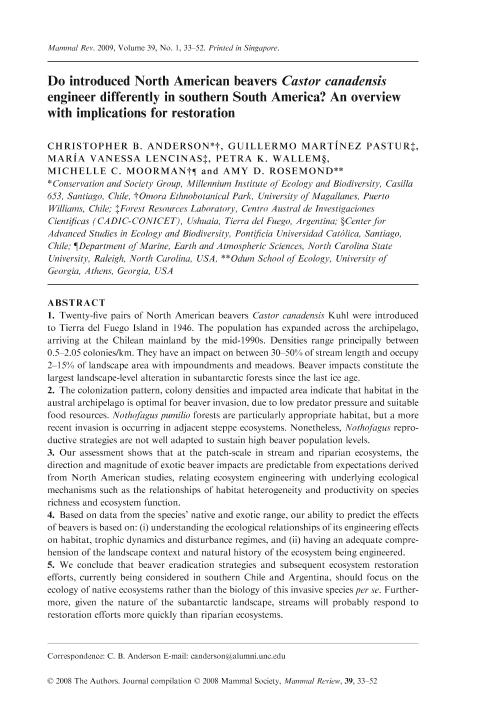Artículo
Do introduced North American beavers Castor canadensis engineer differently in southern South America? An overview with implications for restoration
Anderson, Christopher Brian ; Martínez Pastur, Guillermo José
; Martínez Pastur, Guillermo José ; Lencinas, María Vanessa
; Lencinas, María Vanessa ; Wallem, Petra K.; Moorman, Michelle C.; Rosemond, Amy D.
; Wallem, Petra K.; Moorman, Michelle C.; Rosemond, Amy D.
 ; Martínez Pastur, Guillermo José
; Martínez Pastur, Guillermo José ; Lencinas, María Vanessa
; Lencinas, María Vanessa ; Wallem, Petra K.; Moorman, Michelle C.; Rosemond, Amy D.
; Wallem, Petra K.; Moorman, Michelle C.; Rosemond, Amy D.
Fecha de publicación:
01/2009
Editorial:
Wiley Blackwell Publishing, Inc
Revista:
Mammal Review
ISSN:
0305-1838
Idioma:
Inglés
Tipo de recurso:
Artículo publicado
Clasificación temática:
Resumen
1. Twenty-five pairs of North American beavers Castor canadensis Kuhl were introduced to Tierra del Fuego Island in 1946. The population has expanded across the archipelago, arriving at the Chilean mainland by the mid-1990s. Densities range principally between 0.5-2.05 colonies/km. They have an impact on between 30-50% of stream length and occupy 2-15% of landscape area with impoundments and meadows. Beaver impacts constitute the largest landscape-level alteration in subantarctic forests since the last ice age. 2. The colonization pattern, colony densities and impacted area indicate that habitat in the austral archipelago is optimal for beaver invasion, due to low predator pressure and suitable food resources. Nothofagus pumilio forests are particularly appropriate habitat, but a more recent invasion is occurring in adjacent steppe ecosystems. Nonetheless, Nothofagus reproductive strategies are not well adapted to sustain high beaver population levels. 3. Our assessment shows that at the patch-scale in stream and riparian ecosystems, the direction and magnitude of exotic beaver impacts are predictable from expectations derived from North American studies, relating ecosystem engineering with underlying ecological mechanisms such as the relationships of habitat heterogeneity and productivity on species richness and ecosystem function. 4. Based on data from the species' native and exotic range, our ability to predict the effects of beavers is based on: (i) understanding the ecological relationships of its engineering effects on habitat, trophic dynamics and disturbance regimes, and (ii) having an adequate comprehension of the landscape context and natural history of the ecosystem being engineered. 5. We conclude that beaver eradication strategies and subsequent ecosystem restoration efforts, currently being considered in southern Chile and Argentina, should focus on the ecology of native ecosystems rather than the biology of this invasive species per se. Furthermore, given the nature of the subantarctic landscape, streams will probably respond to restoration efforts more quickly than riparian ecosystems.
Palabras clave:
CASTOR CANADENSIS
,
ECOSYSTEM ENGINEER
,
EXOTIC
,
INVASION
,
NOTHOFAGUS
,
PATAGONIA
Archivos asociados
Licencia
Identificadores
Colecciones
Articulos(CADIC)
Articulos de CENTRO AUSTRAL DE INVESTIGACIONES CIENTIFICAS
Articulos de CENTRO AUSTRAL DE INVESTIGACIONES CIENTIFICAS
Citación
Anderson, Christopher Brian; Martínez Pastur, Guillermo José; Lencinas, María Vanessa; Wallem, Petra K.; Moorman, Michelle C.; et al.; Do introduced North American beavers Castor canadensis engineer differently in southern South America? An overview with implications for restoration; Wiley Blackwell Publishing, Inc; Mammal Review; 39; 1; 1-2009; 33-52
Compartir
Altmétricas



